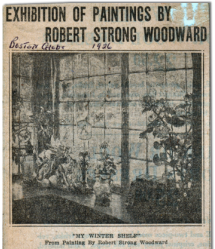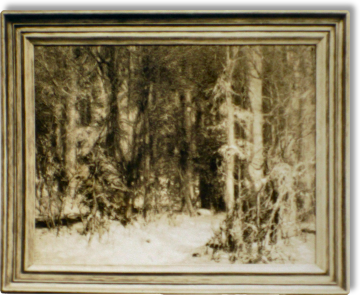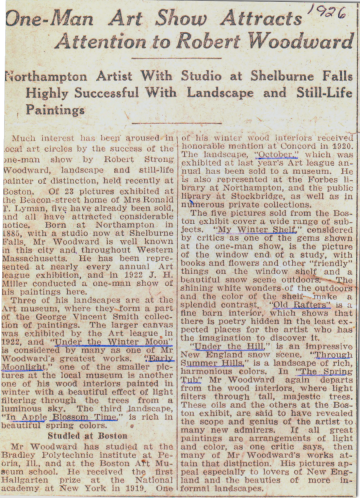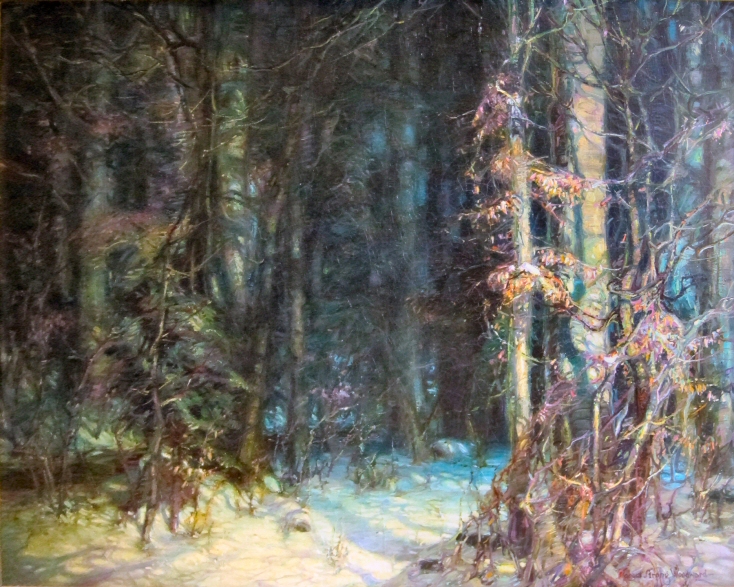Quick Reference
1922
Behind Redgate Studio
Oil on Canvas
Landscape
Woods, Quintessential Redgate
40" x 50"
National Academy of Design, 1921
Springfield Art League, 1922
J.H. Miller Galleries, 1922
George Walter Vincent Smith
Art Museum, Springfield, MA
via the J.H. Miller Galleries.
NA
Related Links
- See also the Woods Gallery to view related pieces.
- See also the Quintessential Redgate Gallery to view related pieces.
- For more about the Redgate Studio, see our Scrapbook page.
- For more about the Springfield Museum, letters & documents regarding this painting.
- Checkout more Articles regarding Woodward.
- See also the Exhibition List for other Exhibits.
- See also our Scapbook page of known Artwork held by Public Institutions.
Other paintings in the G.W.V. Smith Collection:
- Through the Hills in May, still held in collection
- Early Moonlight, whereabouts unknown
- Evening Mists, whereabouts unknown
- See the Scrapbook story

about the Lyman Residence Exhibition, 1926 for more.
Featured Artwork: Under the Winter Moon
RSW's Diary Comments

 Springfield Museum file photograph
Springfield Museum file photograph
"Painted circa 1922. A horizontal large 40" x 50" painted in 'Redgate' at the time I was making many moonlit woodland canvases following the N.A. D. Hallgarten Prize in 1919. Moonlight in deep winter, snow, woodland, composed in the studio from elements and studies of the Redgate night woods. Before he died, bought in the early 20's by Mr. G. W. V. Smith, the owner and director of the George Walter Vincent Smith Art Museum of Springfield, Mass. where it now hangs together with 2 25" x 30"'s of mine, namely... (blank)"
Letter to J.H. Miller by Woodward and forwarded to G.W.V. Smith:
Regarding G.W.V. Smith's interest in buying this picture, he graciously expresses the honor of being considered, however, the price offered for it has RSW ill-at-ease. He already allowed himself to be talked down from $1200.00 to $750.00. We would learn in Woodward's second letter directly to Smith himself that the offer was a quarter ($400) of RSW's original asking price and possibly insulted, RSW, invokes a bit of self promotion and prideful hubris, telling Miller:
...Except to a museum or public gallery I cannot think of letting it go for less than it's marked price of $1200.00. I think there is no question in the world but what in a few years, when the name of Woodward has made its mark it will be worth several thousand. It is a solid thing which will last. This all sounds very much like blowing my own horn, yet in truth it is not exactly that, but more the echo of other horns!
The offer of $400 for such a painting,() that is STILL in the collection to this day) was insulting. What's more is, we learn from these letters that RSW is struggling to make ends meet; what his monthly expenses are regarding his nurse and horse; how long it takes him to paint a 40" x 50"" painting, as well as, his need for a new wheelchair.
Letter to G.W.V. Smith by Woodward himself:
The following quote taken from a letter directly to G.W.V. Smith. RSW is in a struggle to not under sell this painting in order for it to hang in Smith's collection. He has already gone down to $750 from $1200 and is setting a basement price of $600. However, apparently Smith's offer still seems to stand at $400. Woodward is struggling financially. He has enormous expenses (mostly attributed to his nurse) of $350/month. That is $4,800 in today's dollar! He is in need of a new wheelchair and needs to feed his horse and purchase more firewood. So what he writes to Smith is simply classic Woodward:
We know that the painting was eventually purchased by Mr. Smith, however, we do NOT know the actual price paid by Smith. Unlike Through the Hills in May, also in the Smith collection, there was no record or receipt found to confirm its sale.
Additional Notes

 Click on image to see full version
Click on image to see full version
Right: In an unidentified Springfield paper (probably the Springfield Union), writing of his exhibit at the home of Mrs. Ronald Lyman on 38 Beacon St., Boston, in December 1926, "The larger canvas was exhibited by the Art League in 1922, and Under the Winter Moon is considered by many as one of Mr. Woodward's greatest works." This painting did NOT exhibit at Lyman but was mentioned simply as part of the reporter's profile and background of RSW's accomplishments.
Springfield Republican, March 1922.
"... A large canvas, imaginative and highly beautiful..."
"On entering the gallery of the City library where hangs the third annual exhibition of the Springfield Art League,
ones notice is attracted by a striking canvas on the further wall, Under the Winter Moon, by R. S. Woodward. Of qualities that may go to the making of a good painting it has mystery,
it intrigues us. Its technique is interesting. Note the fluid application of paint (as contrasted for example with the dry brush work in Mr. Jones's high-keyed, misty Spring). The handling is direct;
there is no fumbling after-effect. One recalls a test suggested by Royal Cortissoz in his lecture the other night. You can take five square inches out of this canvas of Woodward's anywhere and find
it beautiful, both in color and pattern. And yet the picture is far from diffuse; it has a splendid coherence and subordination to the central point of interest."
 This painting is still in the G.W.V. Smith collection of the Springfield Museum system. It is not hanging but rather in storage. Museum records show
that the painting suffered from web cracking due to a commercialized pre-treatment of animal glue to the canvas. The glue hardened over time, became brittle and started the cracking. It was treated
and restored in 1969.
This painting is still in the G.W.V. Smith collection of the Springfield Museum system. It is not hanging but rather in storage. Museum records show
that the painting suffered from web cracking due to a commercialized pre-treatment of animal glue to the canvas. The glue hardened over time, became brittle and started the cracking. It was treated
and restored in 1969.

.png)

